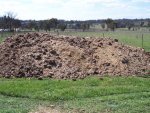Peter W
Admin

At George chicken farm nothing goes to waste. the chicken droppings is a very good raw material for making animal feed and manure," George says - 47-year-old farmer, who resigned from his teaching profession now rearing about 5,000 layers.
Preparing the droppings in animal feeds and manure is a thorough process. First, the droppings are collected from the chicken house, then they spread smoothly in a greenhouse located close to the chicken production area where they are dried for three to five days depending on the weather, as George informs.
He says the greenhouse is preferred to keep bacteria and impurities off the droppings while adding value and maintaining moisture content. "The greenhouse is hot and this speeds up the waste drying process,"
After drying, the droppings are moved to a sieving room in another greenhouse where it is kept for at least two days to monitor its dryness further. When that is done, it is placed on a sieve and manually crushed by the farm workers. Impurities from the sieving room are collected as manure and sold to farmers. Then the refined droplets are collected and packaged in 90 kilos sacks at Sh 500 within Nakuru which is very high on demand. John is one of the Kiamunyi estate dairy farmers who has been purchasing the waste for his cows for the past two years. The farmer says he mixes the waste with the starter and good quality hay. "I buy the waste that I give to my cows to supplement feeds which are expensive," he says. In contrast to what is sold from other farmers, John prefers George's animal feeds because they are adulterated and expensive to buy.
But where did George learn this unique trick?
"I got this knowledge from successful dairy farmers about adding value to chicken dropping and various feed training I attended. Before he went into adding value to chicken droppings, George used to freely give it to neighbors who would use it for crop production. They noticed its value with time and kept coming back for more.
"so I really never knew I could earn good cash even from chicken waste, I used to give it freely, but now I know better," he says. He says he feeds his dairy dairy dairy dairy dairy cows, goats, and sheep, he mixes the finer crashed waste with dairy meals that contain a high nutritional value. On the farm, dairy cows are fed twice a day on the fine chicken waste, failure to which they record a two-liter drop of milk. It helps with digestion as well.
"Chicken waste increases the amount of milk of and improves the skin of the animals." Even though he has broken even, he says more needs to be done to address the issue of commercial animal feeds which will be affordable to smallholder farmers. He tells that the Government should step in to regulate the quality of animal feeds and keep sampling those sold in the market.
Last edited by a moderator:
